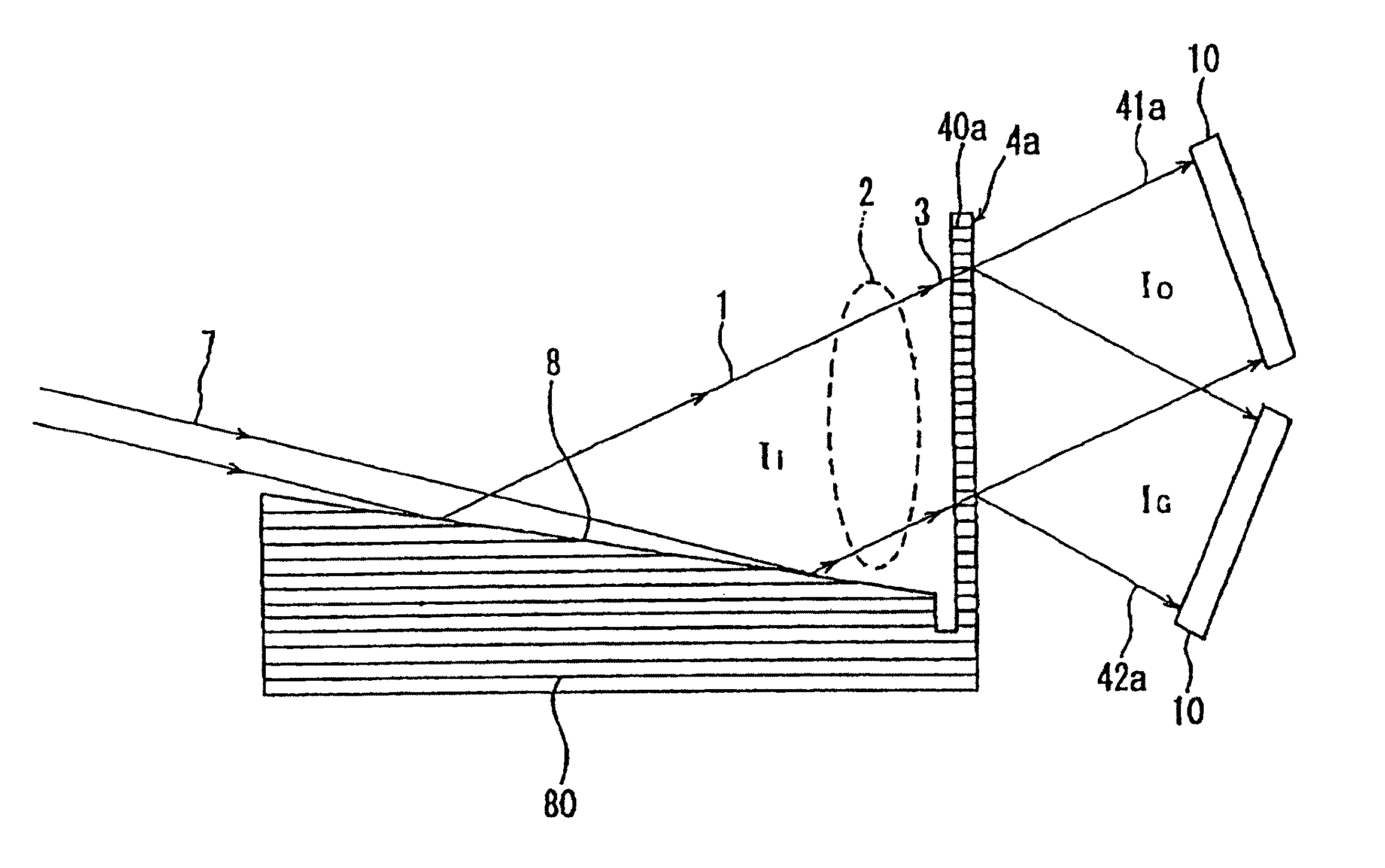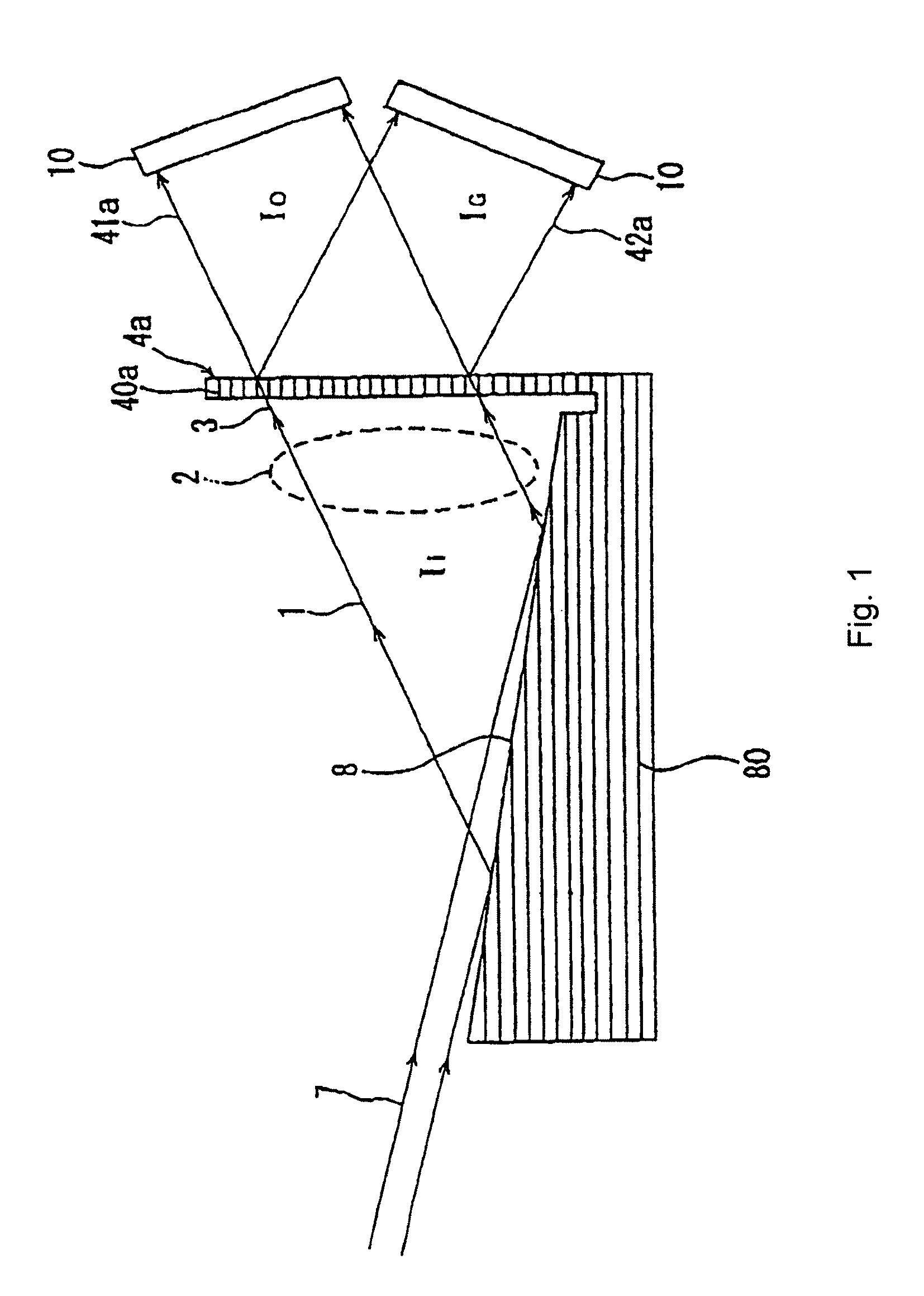Nondestructive analysis method, nondestructive analysis device, and specific object analyzed by the method/device
a non-destructive analysis and analysis method technology, applied in material analysis using wave/particle radiation, instruments, nuclear engineering, etc., can solve the problems of not being able difficult to recognize images, and inability to obtain nothing other than poor contras
- Summary
- Abstract
- Description
- Claims
- Application Information
AI Technical Summary
Problems solved by technology
Method used
Image
Examples
first embodiment
[0078]The invention of this application uses, for example, monochromators or asymmetric monochromators as pre crystal devices which serve as monochromatization and parallelization means. In this case, it is predicated that the monochromators or asymmetric monochromators are arranged with their atomic lattice planes in parallel with the atomic lattice planes of a transmission-type analyzer crystal (4a) or a reflection-type analyzer crystal (4b), so that an achromatic condition (the condition for simultaneous diffraction in all the wavelengths including an accompanying wavelength distribution Δλ of the wavelength λ of the monochromatic X-rays) is satisfied to reduce the angular distribution of the resulting diffraction X-rays as much as possible for increased angular sensitivity (which refers to a difference of relative magnitude of the angular distribution of X-rays obtained from the X-rays from the object with respect to the angular distribution of the monochromatic parallel X-rays ...
second embodiment
[0102]Now, in the case of a reflection-type analyzer crystal, it is publicly known that an X-ray bright-field image is obtained since monochromatic parallel X-rays passing through an object without causing reaction with the object are reflected by the reflection-type analyzer crystal on the one hand while X-rays from the object are observed at the same time. The present invention consists in that an X-ray dark-field image is obtained for situations where monochromatic parallel X-rays passing through an object without causing reaction with the object are reflected, not transmitted, by the reflection-type analyzer crystal on the one hand while X-rays from the object are transmitted by the reflection-type analyzer crystal in the transmission direction and observed on the other hand.
[0103]For example, as illustrated in FIGS. 8(a), 8(b), and 9, when a reflection-type analyzer crystal (4b) is used, an object (2) to be analyzed is irradiated with monochromatic parallel X-rays Ii (1) via an...
third embodiment
X-Ray Detecting Device
[0116]In the first embodiment and second embodiment described above, the X-rays from the transmission-type analyzer crystal (4a) or the reflection-type analyzer crystal (4b) are detected by the X-ray detecting devices (10). These X-ray detecting devices (10) may be flat-type panels, columnar panels, or the like based on two-dimensional detectors (such as an X-ray film, a nuclear plate, an X-ray image pick-up tube, an X-ray fluorescence multiplier tube, an X-ray image intensifier, an X-ray imaging plate, an X-ray CCD, and an X-ray imaging detector by amorphous element), or line sensor one-dimensional detectors.
[0117]Which X-ray detecting devices (10) to use may be selected arbitrarily depending on the type, condition, and the like of the object (2) to be analyzed. In addition, combination scanning of, for example, object movement, rotation, tilt, etc., with the line sensor one-dimensional detectors or two-dimensional detectors is useful for the creation of tomog...
PUM
| Property | Measurement | Unit |
|---|---|---|
| thicknesses | aaaaa | aaaaa |
| thicknesses | aaaaa | aaaaa |
| wavelength | aaaaa | aaaaa |
Abstract
Description
Claims
Application Information
 Login to View More
Login to View More - R&D
- Intellectual Property
- Life Sciences
- Materials
- Tech Scout
- Unparalleled Data Quality
- Higher Quality Content
- 60% Fewer Hallucinations
Browse by: Latest US Patents, China's latest patents, Technical Efficacy Thesaurus, Application Domain, Technology Topic, Popular Technical Reports.
© 2025 PatSnap. All rights reserved.Legal|Privacy policy|Modern Slavery Act Transparency Statement|Sitemap|About US| Contact US: help@patsnap.com



